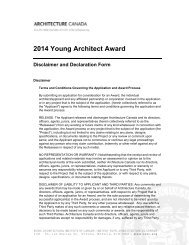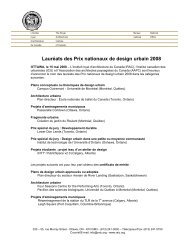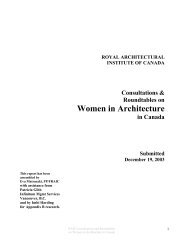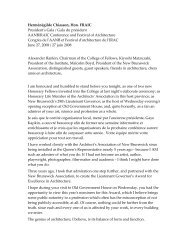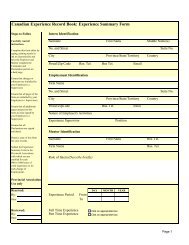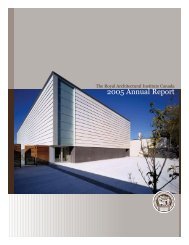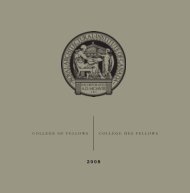Benchmark Study on Green Buildings - Royal Architectural Institute ...
Benchmark Study on Green Buildings - Royal Architectural Institute ...
Benchmark Study on Green Buildings - Royal Architectural Institute ...
You also want an ePaper? Increase the reach of your titles
YUMPU automatically turns print PDFs into web optimized ePapers that Google loves.
m<strong>on</strong>thly quiz, they can win an envir<strong>on</strong>mental picture book <strong>on</strong> animals endangered by<br />
global warming. The company aims to promote participatory approaches for<br />
envir<strong>on</strong>mental communicati<strong>on</strong> and c<strong>on</strong>tribute to solving global envir<strong>on</strong>mental problems<br />
through the program.<br />
LPG fuel cell systems:<br />
So<strong>on</strong> after the Tokyo Gas Corporati<strong>on</strong> had made its Lifuel initiative public, the Japan<br />
Energy Corp., a Japanese refiner and energy producer, announced that it started installing<br />
an LPG reforming stati<strong>on</strong>ary fuel cell system in typical households. The company began<br />
promoting the system mainly in the Kanto area (surrounding Tokyo), installing 30 units<br />
in the first year, and a total of 150 units within the next three years. The home fuel cell<br />
system has an electricity generati<strong>on</strong> capacity of 700 watts and a hot water tank capacity<br />
of 200 liters, with a 65 percent or higher combined efficiency (higher heating value<br />
standards). Liquefied petroleum gas, or LPG, is used as fuel. The company c<strong>on</strong>cludes<br />
what it calls the “JOMO Smile L C<strong>on</strong>tract,” a three-year c<strong>on</strong>tract for fuel cell<br />
maintenance, with users, asking them to provide data and answer questi<strong>on</strong>naires <strong>on</strong> the<br />
system usage. The company covers installati<strong>on</strong> and maintenance costs for the fuel cell<br />
system, while users <strong>on</strong>ly bear LPG fuel costs. This undertaking utilizes subsidies from the<br />
Stati<strong>on</strong>ary Fuel Cell Extensive Dem<strong>on</strong>strati<strong>on</strong> Project of 2005, promoted by New Energy<br />
Foundati<strong>on</strong>, which encourages technical development and practical applicati<strong>on</strong>s of fuel<br />
cell systems.<br />
Biomass Town Program:<br />
In 2006, the Japanese Ministry of Agriculture, Forestry and Fisheries (MAFF) released a<br />
comprehensive evaluati<strong>on</strong> report to examine progress made to date with its policies under<br />
the Biomass Nipp<strong>on</strong> Strategy, which promotes the nati<strong>on</strong>wide use of biomass, during the<br />
base years of 2002 through 2005. According to the evaluati<strong>on</strong> from the nati<strong>on</strong>wide<br />
perspective, the overall utilizati<strong>on</strong> of waste biomass increased from 68 to 72 percent<br />
(carb<strong>on</strong> equivalent), and the recycling rate of food waste improved from 10 to about 20<br />
percent. Meanwhile, the utilizati<strong>on</strong> of unused biomass such as wood thinned from forests<br />
and rice straw remained unchanged at about 20 percent since the launch of the strategy,<br />
and the commercial use of energy crops, such as sugarcane and rapeseed, was negligible.<br />
From the regi<strong>on</strong>al perspective, as of February 2006, 35 municipalities had announced<br />
plans for comprehensive and appropriate use of biomass based <strong>on</strong> the Biomass Town<br />
Program. From the technological perspective, the producti<strong>on</strong> efficiency of biomassderived<br />
plastics showed a year-<strong>on</strong>-year increase of 20 percent, exceeding the initial goal<br />
of 10 percent. The report, calls for positive efforts to realize the goals of Biomass Nipp<strong>on</strong>,<br />
and suggests five specific acti<strong>on</strong>s: promoting reducti<strong>on</strong>s in the volume of food waste and<br />
greater efforts to sort this waste; enhancing the use of forest residues as unused biomass<br />
for product materials and energy sources; realizing the stable and low-cost producti<strong>on</strong> of<br />
energy crops and cultivating them <strong>on</strong> aband<strong>on</strong>ed farmland; fostering human resources for<br />
the development of the Biomass Town Program; and establishing producti<strong>on</strong> systems for<br />
biomass-derived plastics similar to those for oil-derived plastics. On March 31, 2006, the<br />
Japanese Cabinet approved a revisi<strong>on</strong> of the Biomass Nipp<strong>on</strong> Strategy, with the view that<br />
it is important to promote the use of biomass energy for transportati<strong>on</strong> fuels. Other<br />
92



